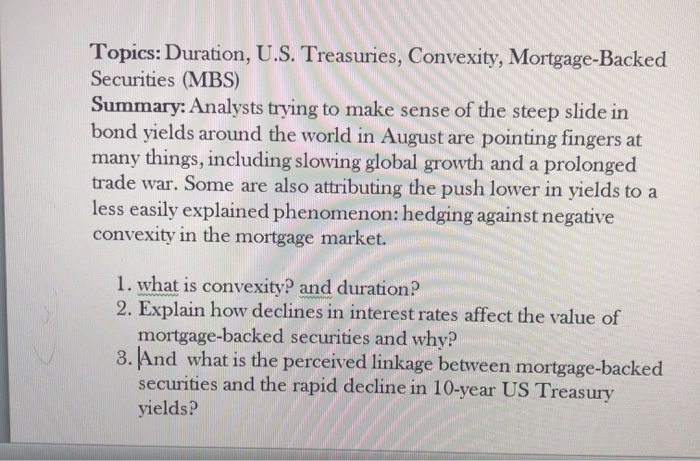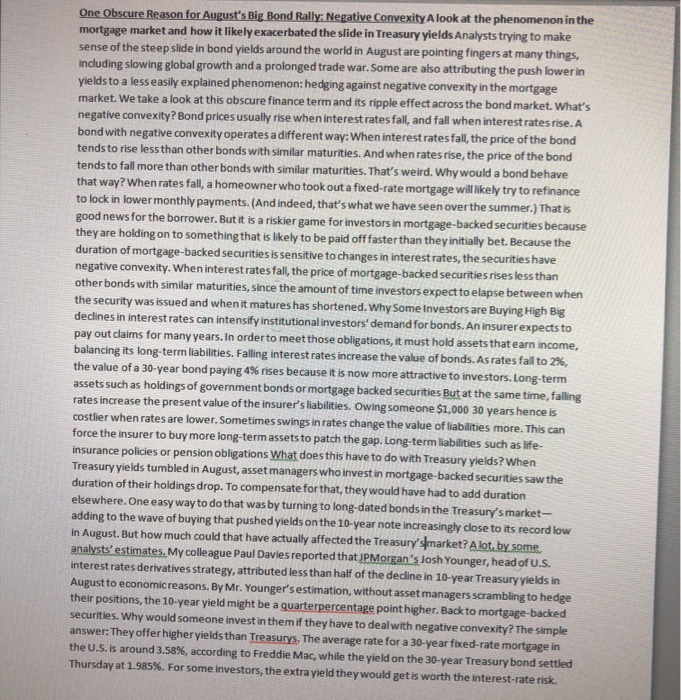Topics: Duration, U.S. Treasuries, Convexity, Mortgage-Backed Securities (MBS) Summary: Analysts trying to make sense of the steep slide in bond yields around the world in August are pointing fingers at many things, including slowing global growth and a prolonged trade war. Some are also attributing the push lower in yields to a less easily explained phenomenon: hedging against negative convexity in the mortgage market. 1. what is convexity and duration? 2. Explain how declines in interest rates affect the value of mortgage-backed securities and why? 3. And what is the perceived linkage between mortgage-backed securities and the rapid decline in 10-year US Treasury yields? One Obscure Reason for August's Big Bond Rally: Negative Convexity A look at the phenomenon in the mortgage market and how it likely exacerbated the slide in Treasury yields Analysts trying to make sense of the steep slide in bond yields around the world in August are pointing fingers at many things, including slowing global growth and a prolonged trade war. Some are also attributing the push lowerin yields to a less easily explained phenomenon: hedging against negative convexity in the mortgage market. We take a look at this obscure finance term and its ripple effect across the bond market. What's negative convexity? Bond prices usually rise when interest rates fall, and fall when interest rates rise. A bond with negative convexity operates a different way: When interest rates fall, the price of the bond tends to rise less than other bonds with similar maturities. And when rates rise, the price of the bond tends to fall more than other bonds with similar maturities. That's weird. Why would a bond behave that way? When rates fall, a homeowner who took out a fixed-rate mortgage will likely try to refinance to lock in lower monthly payments.(And indeed, that's what we have seen over the summer.) That is good news for the borrower. But it is a riskier game for investors in mortgage-backed securities because they are holding on to something that is likely to be paid off faster than they initially bet. Because the duration of mortgage-backed securities is sensitive to changes in interest rates, the securities have negative convexity. When interest rates fall, the price of mortgage-backed securities rises less than other bonds with similar maturities, since the amount of time investors expect to elapse between when the security was issued and when it matures has shortened. Why Some Investors are Buying High Big declines in interest rates can intensify institutional investors' demand for bonds. An insurer expects to pay out claims for many years. In order to meet those obligations, it must hold assets that earn income, balancing its long-term liabilities. Falling interest rates increase the value of bonds. As rates fall to 2% the value of a 30-year bond paying 4% rises because it is now more attractive to investors. Long-term assets such as holdings of government bonds or mortgage backed securities But at the same time, falling rates increase the present value of the insurer's liabilities. Owing someone $1.000 30 years hence is costlier when rates are lower. Sometimes swings in rates change the value of liabilities more. This can force the insurer to buy more long-term assets to patch the gap. Long-term liabilities such as life- insurance policies or pension obligations What does this have to do with Treasury yields? When Treasury yields tumbled in August, asset managers who invest in mortgage-backed securities saw the duration of their holdings drop. To compensate for that, they would have had to add duration elsewhere. One easy way to do that was by turning to long-dated bonds in the Treasury's market- adding to the wave of buying that pushed yields on the 10-year note increasingly close to its record low in August. But how much could that have actually affected the Treasury'smarket? A lot by some analysts'estimates. My colleague Paul Davies reported that JPMorgan's Josh Younger, head of U.S. interest rates derivatives strategy, attributed less than half of the decline in 10-year Treasury yields in August to economicreasons. By Mr. Younger's estimation, without asset managers scrambling to hedge their positions, the 10-year yield might be a quarterpercentage point higher. Back to mortgage-backed securities. Why would someone invest in them if they have to deal with negative convexity? The simple answer: They offer higher yields than Treasurys. The average rate for a 30-year fixed-rate mortgage in the U.S. is around 3.58%, according to Freddie Mac, while the yield on the 30-year Treasury bond settled Thursday at 1.985%. For some investors, the extra yield they would get is worth the interest-rate risk








